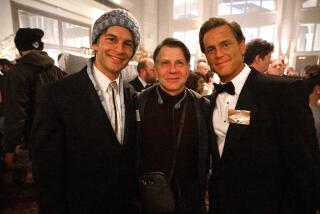Ahhh, Humbuck! : Seth Lover’s amplitude of talent turned up the volume of pop--including ‘horrible music’--and produced the Humbucker pickup. His Garden Grove garage is an electronic treasure trove.
- Share via
GARDEN GROVE — There have been times at Seth Lover’s house when the 83-year-old electronics engineer is working in the garage while neighbor kids are out in their driveways waxing their four-wheel-drive vehicles, the doors open with the cassette deck blasting out a heavy metal ruckus.
Lover doesn’t especially love that brand of sonic endeavor, believing, “If you can’t hum it, it’s not music.” Still, the kids have cranked it up at times, heedless of his displeasure, and still more heedless of the distinct possibility that such music might not even exist were it not for their quiet neighbor and his tinkerings.
Back in the ‘50s, Lover worked for the Gibson guitar company and designed a guitar pickup (a device that senses a string’s signal and sends it on to an amplifier) called the Humbucking pickup, with the intent of removing electrical interference from the sound (bucking the hum).
The pickup also had the side-effect of being louder than others, a fact noted a decade later by Eric Clapton, Jimmy Page, Jeff Beck and a legion of followers who used Lover’s Humbucking pickup to create a new, distorted realm of sound.
Additionally, around 1961, Lover had designed the first fuzztone distortion device. Using one of his boxes, the Stones in 1965 came up with the immortal buzzy guitar line on “Satisfaction.”
Soon everyone was using fuzzboxes, and, while younger generations have enjoyed the fruits of Lover’s efforts, he doesn’t go out of his way to take credit for this louder world he’s made. Not that misgivings slowed him down any: Working for Fender in Fullerton in the late ‘60s, Lover went on to design an amplifier so loud--with 1,000 watts--that it was the first amp ever to carry a hearing-loss warning label.
*
One of these hulking brutes looms behind Lover as he sits at his workbench in a garage piled to the rafters with electronic gear, test equipment, old radios, boxes of vacuum tubes and sundry items, as well as a grain-roaster he built so he and his wife could make barley “coffee.” Most afternoons still, he’s in the garage, coming up with new pickup designs, fixing radios and young rockers’ amps or junking old gear for parts he can use.
Like the late Orange County electric guitar pioneers Leo Fender and Doc Kaufman, Lover is an inveterate tinkerer of the “American know-how” school who just can’t leave well enough alone, often coming up with something better than “well enough” in the process.
Motioning with one hand toward his project-crowded garage, Lover said, “I call this my Ph.D.: piled higher and deeper.”
*
It’s about as close to higher education as he comes. He was born Jan. 1, 1910, in a farming area on the outskirts of Kalamazoo, Mich. His family split up and then his father died when Lover was 15, and he was taken in by a farmer who offered to send him to high school if Lover would work for him.
“The thing was, the guy didn’t send me to high school. If it was raining I could go, but if it was nice weather he made me work,” Lover recalled. For three years in a row, he had to drop the classes he’d start because work or transportation problems got in the way.
When he was 12 he had sold seeds door-to-door--”not so easy when the doors are far apart in the country like that,” he claims--to earn a crystal set, which proved such a cheap disappointment that he determined to build his own radio. He got a schematic out of the Philadelphia Public Ledger newspaper, saved for parts, and pieced it together.
Finally he turned it on, and “the first station I heard was WDZ in Springfield, Mass. Boy, I was really happy then because that was a long way off.” That thrill got him hooked, and he subscribed to a mail-order radio course.
Lover enlisted in the Army at 18 and was assigned to an artillery unit where, he said, “I got acquainted with horses again because they still used them to pull the field artillery then.” While in the service, he took another radio course, and after his hitch he returned to Kalamazoo, where he repaired radios for several years before going to work for Gibson right before World War II.
He did two stints with the Navy, training radiomen, but otherwise was with Gibson until 1967. During that time, he designed most of their amplifiers, guitar electronics and effects.
He also had other interests, as reflected by a front-page article in a yellowed 1948 copy of the Kalamazoo Gazette he still has. Entitled “Television Comes to Kalamazoo,” it read:
Television came to Kalamazoo Friday evening, paid a flickering visit and then faded into the night. Five members of the Kalamazoo Radio Technicians association working with experimental equipment managed to complete the first successful reception of a television broadcast to be reported in Kalamazoo.... “We had them for a short time,” says Seth E. Lover, one of the experimenters. “Now that we know it can be done, it is up to us to build the equipment to make it practical for others.”
Lover says that when he went to work for Gibson, “I didn’t know one end of a guitar from another,” and he still doesn’t play. Some of his ideas resulted from inspiration and research, while others had less noble beginnings.
He designed one Gibson effect, called a Varitone, he said, “because we’d inherited all these switches from another company we’d purchased, and it was either find something to do with them or throw them out.”
The fuzztone was the result of trying to duplicate a defect.
“One of our salesmen came in talking about a guitarist in Tennessee (most likely Paul Burlison, wild rockabilly guitarist with the Johnny Burnette Trio) who had an amp where something had gone wrong, causing this fuzzy distortion, and he kinda liked it. So we figured, ‘Let’s give them distortion, if that’s what they’re looking for,’ found a way to cause it with transistors and we called it the fuzztone,” he said.
He has mixed feelings about the part he’s played in the prominence of the electric guitar.
“Back in the early ‘30s, I designed audio amplifiers for a bandleader, and at the time guitar players just had acoustic guitars. You could see him waving his arms strumming back there, but you couldn’t hear him. I can see why the electric guitar was needed. The thing is, I felt they should have kept those bandleaders, somebody who, instead of letting every guitar player play as loud as possible, would tell him to quiet down.”
As for his 1,000-watt amp, he opines: “I designed an amp that would play and put out a lot of power. How they treat it is something else. If you play decent music through it, it sounds decent. If you play horrible music through it, it sounds horrible.”
While museums now house many less influential inventions and more ephemeral bits of music history, Lover keeps his original Humbucking pickup in a cigar box.
Early production models of the pickup--distinguished by decals on the bottom reading “Patent Applied For”--sell for up to $500 each now, twice what a whole Les Paul guitar went for in 1958.
Those vintage guitars, meanwhile, now command prices in the $30,000 range, in large part because they were the first Les Pauls equipped with Lover’s Humbucking pickups.
Since then, Gibsons and other guitars in the millions have employed his Humbucking pickup design. While guitarist Les Paul--who by most informed accounts except his own had very little to do with the design of the guitar bearing his name--has been lionized, Lover has been all but forgotten.
A few years back, Gibson ran ads commemorating the 25th anniversary of the Humbucking pickup, which, to add to its historical look, included the bold signature of the patent holder, Seth E. Lover. The only problem was, it wasn’t Lover’s signature, just some ad person’s forgery.
“I contacted Gibson and told them I’d have been glad to give them my signature,” Lover said. “They told me they didn’t know I was still alive.”
*
Lover had left Gibson for Orange County’s Fender in 1967, where he designed pickups, amps and effects until he was forced to retire in 1975 when he turned 65. “I think they should have kept me on longer. I didn’t feel I was ready for the junk heap,” he complained.
Since he has retired he has been busier than ever, he says, in part because he has to be. He receives a small retirement from Fender and Gibson (which sends him $42 a month), but “if we want to eat once in a while, I have to work,” he says. He makes no money off his patents, since they became the property of his employers. The ideas he has had since, he says, he can’t afford to patent.
Now, most mornings he delivers broken vacuum cleaners from a thrift store to a repairman for a small fee. He always checks out the thrift store as-is yard, as well as local swap meets, for radio or amp bargains he might fix and sell. His wife of 55 years, Lavone (“it rhymes with telephone,” she says), is accustomed to his disappearing into his cluttered mad-scientist garage for the better part of the day. At his work bench, if he can’t fix something, he’ll strip it down for parts, carefully de-soldering resistors he might be lucky to sell off for five cents apiece.
Does it ever rankle him that he didn’t get the attention accorded a Leo Fender or Les Paul?
“I never think about it,” he said plainly.
“Seth certainly deserves to be honored,” says one person in the music industry who hasn’t forgotten him.
Seymour Duncan’s Santa Barbara-based replacement-pickup business has become a global success, due in no small part to Duncan’s caring re-creations of Lover’s ‘50s designs. Duncan now markets about 125 variations on the Humbucking pickup.
“I look on him as a father figure,” Duncan said. “He doesn’t care about the limelight, but music would be a lot different without him. I learned a lot visiting him in that Garden Grove garage. We’ve been talking about working together on some things. I’d love that because he’d finally earn a royalty on his work and because there’s still so much invention left in that man.”
More to Read
The biggest entertainment stories
Get our big stories about Hollywood, film, television, music, arts, culture and more right in your inbox as soon as they publish.
You may occasionally receive promotional content from the Los Angeles Times.








